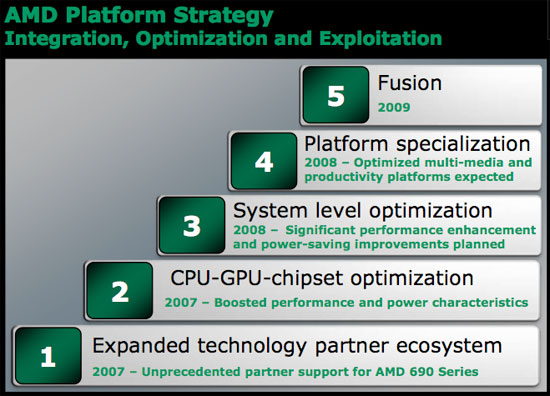AMD's Next-Generation Mobile Architecture Revealed: Griffin
by Anand Lal Shimpi on May 18, 2007 12:10 AM EST- Posted in
- CPUs
Final Words
AMD itself stated that it sees the future of microprocessor design as taking two approaches: one for performance and scalability, largely dictated by the server market, and one coming out of the mobile space; the desktop CPUs would scale up and down from the two design points.
We all know very well that the K8 was designed for performance and scalability, so is a new north bridge, memory controller and better power management enough to make it a mobile core? Or would Griffin have benefited from a truly ground up design, similar to what Intel did when it revamped the P6 core? It's tough to say how much more efficiency could be extracted from the K8 if AMD tried.
That being said, there are some impressive improvements to the chip that should yield significant power savings. The revised memory controller and HT interface from Barcelona are welcome additions, but the support for independent voltages per CPU core is particularly impressive.
Platform features like PowerXPress sound gimmicky today but could be significant if well implemented; unfortunately it looks like we've got at least a year to wait before we find out for sure.

As a side note, you may remember that AMD seemed particularly cautious about sharing too much about its plans for Barcelona/Phenom. AMD stated that it didn't want to clue Intel in on what it had up its proverbial sleeve. However, with Griffin not scheduled for release as late as the middle of 2008, we can't help but wonder if all arms of AMD believe the same things, or if AMD is simply giving us excuses for why we don't get more information today.
At least we know what's coming, and Griffin/Puma look to be AMD's best attempt at mobile computing yet. Whether or not it will be enough to dent Centrino is another matter entirely.










36 Comments
View All Comments
mesyn191 - Friday, May 18, 2007 - link
For the mobile space a cheap power efficient platform (not just a CPU but a NB/SB, wireless chipset, graphics, driver support, etc...) is far more important than sheer CPU performance.Griffin sure won't beat C2D on performance IPC or clockspeed wise but it will provide them with a viable low cost set of one size fits all tech. that they can sell to the OEM's and that is where the major volume (and thus money) is.
Haltech - Friday, May 18, 2007 - link
Unleess AMD thinks they can add Barcelona to the mobile market Intel will continue to add market share in mobile front. Plus it seems like their implying ATI graphics only when talking about discrete graphics.One question- why 6 sata ports and 14 usb ports...
tygrus - Sunday, May 20, 2007 - link
Using desktop chipset becomes a problem of overkill, wasting silicon and power. Need to be slimmed down but that would still be more expensive due to smaller production.
How much power do they use when inactive ?
strikeback03 - Tuesday, May 22, 2007 - link
Are there any desktop chipsets that support 14 USB ports? I don't remember seeing any.JarredWalton - Friday, May 18, 2007 - link
There are plenty of notebook users that want decent performance with LOOOONG battery life. If AMD can provide better typical battery use, they could still make some waves. At present, Turion X2 is already competitive with C2D in low power states, but at load they fall behind. A few optimizations could help them in both areas.Lonyo - Friday, May 18, 2007 - link
But that won't really help them in a years time.Competing in 12 months with what Intel has today means than when Intel has moved on 12 months, they will likely be ahead again, so overall nothing will have changed, although the consumer will reap the benefits :)